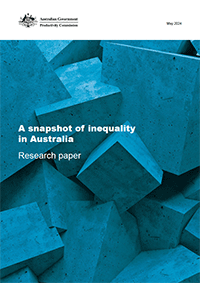A snapshot of inequality in Australia
Research paper
Released 20 / 05 / 2024
This paper provides an update on the state of economic inequality in Australia, reviewing the period of the COVID-19 induced recession and recovery. It also deep dives into economic inequality for three cohorts:
- women
- older people
- Aboriginal and Torres Strait Islander people.

Media release
New research provides a snapshot of inequality in Australia
New research from the Productivity Commission has unpacked changes to income and wealth levels during the COVID-19 pandemic.
“The initial pandemic period saw an unprecedented decline in income inequality. The incomes of lower-income households grew rapidly in relative terms in the early stages of the pandemic, due to the massive increase in support payments from the Government,” said Commissioner Catherine de Fontenay.
“Income inequality increased later in the pandemic period as the economy recovered and government support was phased out.”
The report also finds that wealth inequality fell across the pandemic period.
“Some lower-income Australians were able to save or reduce debt due to early government support. And although house prices soared during the pandemic period, the strongest price increases were in regional areas where house prices are lower. This all had the effect of reducing wealth inequality,” said Commissioner de Fontenay.
The report examines three cohorts in closer detail: older people, women, and Aboriginal and Torres Strait Islander people.
The report finds that while older Australians have relatively low incomes compared to working age Australians, many have significant wealth they can draw on to fund their spending.
“When you look at wealth and income together, older Australians are doing better on average than younger Australians,” said Commissioner de Fontenay.
The report also examines gender differences in income and wealth. It finds that women still have lower income than men at all levels of the distribution, but that the share of women at the top of the income distribution has increased.
“We are seeing some improvements in the income gap between men and women consistent with an increase in women’s workforce participation and a declining gender pay gap,” said Commissioner de Fontenay.
The gap between the average incomes of Aboriginal and Torres Strait Islander people and the Australian average income narrowed slightly early in the pandemic before widening in 2022.
“Economic measures provide only a partial indicator for overall wellbeing. This is a particularly significant consideration in the case of Aboriginal and Torres Strait Islander people, for whom wellbeing encompasses cultural identity, community connections and other measures of quality of life,” said Commissioner de Fontenay.
Media requests
Media team – 02 6240 3330 / media@pc.gov.au
Contents
- Preliminaries: Cover, Copyright and publication detail, Contents and Acknowledgements
- Executive summary
- 1. Why investigate economic inequality in Australia?
- 1.1 What is economic inequality and why examine it again?
- 1.2 How to measure inequality – a policymaker’s toolkit
- 2. Recent changes to inequality in Australia
- 2.1 Income inequality
- 2.2 Wealth inequality
- 2.3 Measures of potential and actual consumption
- 3. Income, transfers and consumption capacity by age
- 3.1 Variations in income and transfers across age groups
- 3.2 Measures of potential and actual consumption suggest less inequality between age groups
- 4. Income, transfers and wealth components by gender
- 4.1 Income snapshot by gender
- 4.2 Gender differences in transfer payments
- 4.3 Men tend to have more assets and debts than women
- 5. Inequality for Aboriginal and Torres Strait Islander people
- 5.1 Wellbeing encompasses more than income
- 5.2 Changes in income during the pandemic
- 5.3 Geography matters for Aboriginal and Torres Strait Islander incomes
- 5.4 Age and gender inequality within Aboriginal and Torres Strait Islander incomes
- Appendix: Inequality measures and data sources
- A.1 Equivalised measures
- A.2 Calculating income
- A.3 Data sources
- References
Printed copies
Printed copies of this report can be purchased from Canprint Communications.
We value your comments about this publication and encourage you to provide feedback.